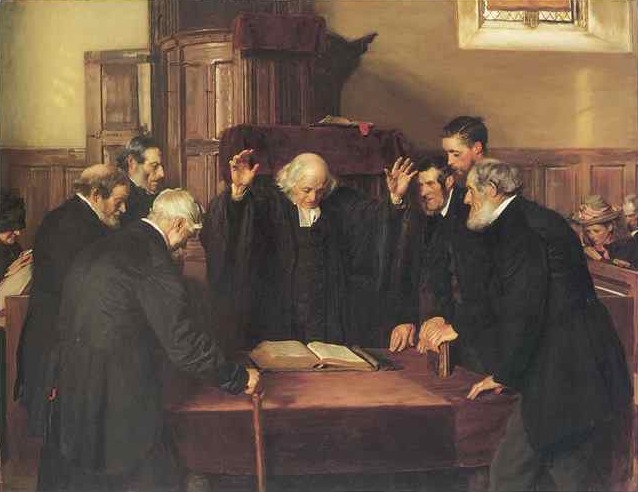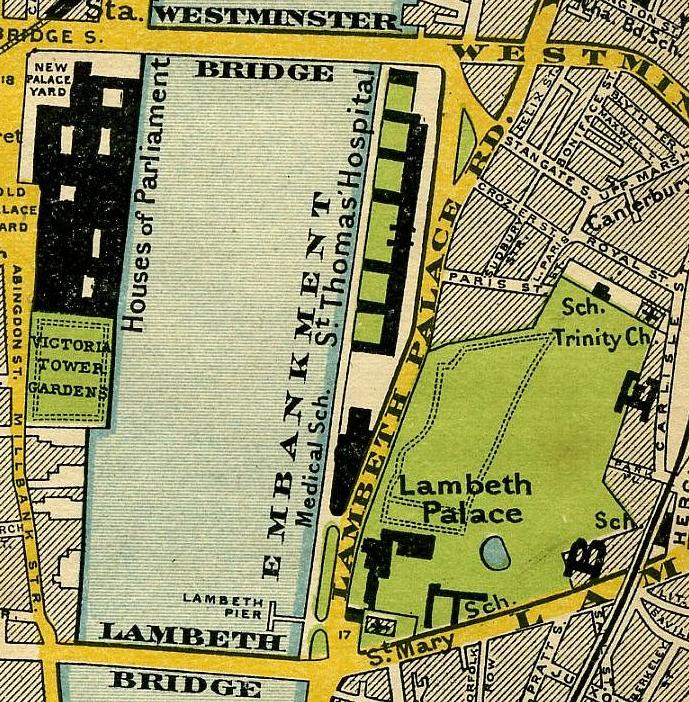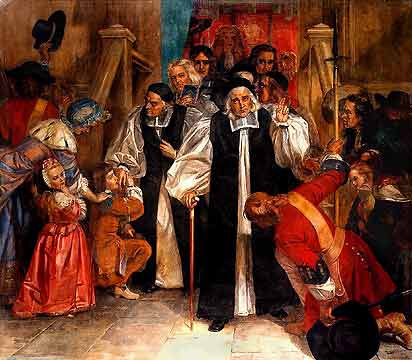|
Offspring Blackall
Ofspring Blackall (26 April 1655 (baptised) – 29 November 1716), Bishop of Exeter and religious controversialist, was born in London. Early life and education Baptized on 26 April 1655 at St Gregory by Paul's, he was the son of Thomas Blackall (bapt. 1621; died 1688), freeman of the Haberdashers' Company and later alderman of the City of London, and his wife, Martha (bapt. 1625; d. 1701?), daughter of Charles Ofspring, rector of St Antholin, Budge Row, and trier of the second presbyterian classis (or eldership) of London. Blackall's father owned land in several counties as well as property in the city, and although he conformed to the established church may have retained some puritan sympathies. During Blackall's youth his parents resided in Lordshold Manor, an 'ancient brick house' in Dalston, Middlesex ( VCH Middlesex, 10.89). He was educated in nearby Hackney, perhaps at the free school of which Robert Skingle was master, before being admitted as a pensioner to St Ca ... [...More Info...] [...Related Items...] OR: [Wikipedia] [Google] [Baidu] |
The Right Reverend
The Right Reverend (abbreviated The Rt Revd, The Rt Rev'd, The Rt Rev.) is a style (manner of address), style applied to certain religion, religious figures. Overview *In the Anglican Communion and the Roman Catholicism in the United Kingdom, Catholic Church in Great Britain, it applies to bishops, except that ''The Most Reverend'' is used for archbishops (elsewhere, all Roman Catholic Church, Catholic bishops are styled as ''The Most Reverend''). *In some churches with a Presbyterian heritage, it applies to the current Moderator of the General Assembly, such as **the current Moderator of the United Church of Canada (if the moderator is an ordained minister; laypeople may be elected moderator, but are not styled Right Reverend) **the current Moderator of the Presbyterian Church in Ireland **the current Moderator of the General Assembly of the Church of Scotland **the current Moderator of the Presbyterian Church of East Africa **the current Moderator of Presbyterian Church of G ... [...More Info...] [...Related Items...] OR: [Wikipedia] [Google] [Baidu] |
Classis (ecclesiastical)
Presbyterian (or presbyteral) polity is a method of church governance ("ecclesiastical polity") typified by the rule of assemblies of presbyters, or elders. Each local church is governed by a body of elected elders usually called the session or ''consistory'', though other terms, such as ''church board'', may apply.For example, the Church of the Nazarene, which subscribes to a body of religious doctrines that are quite distinct from those of most properly named Presbyterian denominations (and which instead descends historically from the Wesleyan Holiness Movement), employs a blend of congregationalist, episcopal, and presbyterian polities; its local churches are governed by an elected body known as the church board or simply "board members"; the term elder in the Nazarene Church has a different use entirely, referring to an ordained minister of that denomination. Groups of local churches are governed by a higher assembly of elders known as the presbytery or classis; presbyte ... [...More Info...] [...Related Items...] OR: [Wikipedia] [Google] [Baidu] |
Lambeth
Lambeth () is a district in South London, England, in the London Borough of Lambeth, historically in the County of Surrey. It is situated south of Charing Cross. The population of the London Borough of Lambeth was 303,086 in 2011. The area experienced some slight growth in the medieval period as part of the manor of Lambeth Palace. By the Victorian era the area had seen significant development as London expanded, with dense industrial, commercial and residential buildings located adjacent to one another. The changes brought by World War II altered much of the fabric of Lambeth. Subsequent development in the late 20th and early 21st centuries has seen an increase in the number of high-rise buildings. The area is home to the International Maritime Organization. Lambeth is home to one of the largest Lusophone, Portuguese-speaking communities in the UK, and is the second most commonly spoken language in Lambeth after English language, English. History Medieval The origins of the ... [...More Info...] [...Related Items...] OR: [Wikipedia] [Google] [Baidu] |
Archbishop Of York
The archbishop of York is a senior bishop in the Church of England, second only to the archbishop of Canterbury. The archbishop is the diocesan bishop of the Diocese of York and the metropolitan bishop of the province of York, which covers the northern regions of England (north of the Trent) as well as the Isle of Man. The archbishop's throne ('' cathedra'') is in York Minster in central York and the official residence is Bishopthorpe Palace in the village of Bishopthorpe outside York. The current archbishop is Stephen Cottrell, since the confirmation of his election on 9 July 2020. History Roman There was a bishop in Eboracum (Roman York) from very early times; during the Middle Ages, it was thought to have been one of the dioceses established by the legendary King Lucius. Bishops of York are known to have been present at the councils of Arles (Eborius) and Nicaea (unnamed). However, this early Christian community was later destroyed by the pagan Anglo-Saxons and ... [...More Info...] [...Related Items...] OR: [Wikipedia] [Google] [Baidu] |
John Sharp (Archbishop Of York)
John Sharp (16 February 1645 – 2 February 1714), English divine who served as Archbishop of York. Biography Memoirs of the Secret Services of John Macky Esq.: John Archbishop of York, is Dr. Sharp, he was a Rector of St Giles in the Fields, in the Reign of King James; when, preaching warmly against Popery, he was silenced, and the Bishop of London ( Dr. Compton) suspended from his office, for not turning him out. He was made by King William Archbishop of York; and this Queen hath made him her Lord Almoner. He is one of the greatest Ornaments of the Church of England, of great Piety and Learning; a Black Man, and fifty-five Years old. John Sharp was born at Bradford, the eldest son of Thomas Sharp, a salter, and Dorothy Weddal. His father was a puritan who enjoyed the favour of Thomas Fairfax and inculcated in him Calvinist, Low Church, doctrines, while his mother, being a strong royalist, instructed him in the liturgy of the Book of Common Prayer. He was educated at ... [...More Info...] [...Related Items...] OR: [Wikipedia] [Google] [Baidu] |
Nonjuring Schism
The Nonjuring schism refers to a split in the State religion, established churches of England, Scotland and Ireland, following the deposition and exile of James II of England, James II and VII in the 1688 Glorious Revolution. As a condition of office, clergy were required to swear allegiance to the ruling monarch; for various reasons, some refused to take the oath to his successors William III of England, William III and II and Mary II of England, Mary II. These individuals were referred to as ''Non-juring'', from the Latin verb ''iūrō'', or ''jūrō'', meaning "to swear an oath". In the Church of England, an estimated 2% of priests refused to swear allegiance in 1689, including nine bishops. Ordinary clergy were allowed to keep their positions but after efforts to compromise failed, the six surviving bishops were removed in 1691. The schismatic Non-Juror Church was formed in 1693 when William Lloyd (bishop of Norwich), Bishop Lloyd appointed his own bishops. His action was opp ... [...More Info...] [...Related Items...] OR: [Wikipedia] [Google] [Baidu] |
St Dunstan-in-the-West
The Guild Church of St Dunstan-in-the-West is in Fleet Street in the City of London. It is dedicated to Dunstan, Bishop of London and Archbishop of Canterbury. The church is of medieval origin, although the present building, with an octagonal nave, was constructed in the 1830s to the designs of John Shaw. History Medieval church It is first mentioned in written records in 1185. But there is no evidence of the date of its original foundation. There is speculation that it might have been erected by Dunstan himself, or by priests who knew him well. Others suggest a foundation date of between AD 988 (death of St Dunston) and 1070. Another speculation is that a church on this site was one of the ''Lundenwic'' strand settlement churches, like St Martin in the Fields, the first St Mary le Strand, St Clement Danes and St Bride's, which may pre-date any within the walls of the City of London. King Henry III gained possession of it and its endowments from Westminster Abbey b ... [...More Info...] [...Related Items...] OR: [Wikipedia] [Google] [Baidu] |
St Olave Jewry
St Olave's Church, Old Jewry, sometimes known as ''Upwell Old Jewry'', was a church in the City of London located between the street called Old Jewry and Ironmonger Lane. Destroyed in the Great Fire of London in 1666, the church was rebuilt by the office of Sir Christopher Wren. The church was demolished in 1887, except for the tower and west wall, which remain today. History St Olave, Old Jewry is dedicated to the 11th-century patron saint of Norway, St Olaf. Old Jewry was the precinct of medieval London largely occupied and populated by Jews until their expulsion from England in 1290. The church is also recorded as ''St Olave in Colechirchlane'' and ''St Olave, Upwell'', the latter appellation coming from a well under the east end of the church. The earliest surviving reference is in a manuscript of c.1130, but excavations made during 1985 uncovered the foundations of a Saxon predecessor, built between the 9th and 11th centuries, from Kentish ragstone and recycled Roman brick ... [...More Info...] [...Related Items...] OR: [Wikipedia] [Google] [Baidu] |
St Mary Aldermary
The Guild Church of St Mary Aldermary a contraction of St Mary Aldermanbury (or St Mary Elder Mary) is an Anglican church located in Watling Street at the junction with Bow Lane, in the City of London. Of medieval origin, it was rebuilt from 1510. Badly damaged in the Great Fire of London in 1666, it was rebuilt once more, this time by Sir Christopher Wren; unlike the vast majority of Wren's City churches, St Mary Aldermary is in the Gothic style. History There has been a church on the site for over 900 years. Its name is usually taken to mean that it is the oldest of the City churches dedicated to the Virgin Mary.Godwin 1839, p.3, referring to a suggestion made by John Stow in his ''Survey of London''. The patronage of the rectory of St Mary Aldermary belonged to the prior and chapter of Canterbury, but was transferred to the Archbishop of Canterbury in 1400.Daniel 1892, p.233 In 1510, Sir Henry Keeble financed the building of a new church. The tower was still unfinished when ... [...More Info...] [...Related Items...] OR: [Wikipedia] [Google] [Baidu] |
South Ockendon
South Ockendon is a town, former civil parish and Church of England parish within the Thurrock borough in Essex in the East of England, United Kingdom. It is located on the border with Greater London, just outside the M25 motorway. The area to the north is North Ockendon. In 2019 it had an estimated population of 22,303 and in the 2021 United Kingdom census it had a population of 22,442 In 1931 the parish had a population of 1355. History South Ockendon is an ancient parish. It was a village before the Norman Conquest, had a priest in 1085.Cyril Hart ''The Early Charters of Essex'' (Leicester University Press, 1971) is listed in the Domesday Book''DB32 Essex'', location=Chichester , publisher=Phillimore, year=1983, section 57b & section 58a as "Wocheduna", conjecturally named after a Saxon chief, Wocca, whose tribe allegedly lived on a hill. The suffix "don" in Old English means a low hill in open country. Until the late 1940s, the village centred on The Village Green, with its N ... [...More Info...] [...Related Items...] OR: [Wikipedia] [Google] [Baidu] |
William Wake
William Wake (26 January 165724 January 1737) was a priest in the Church of England and Archbishop of Canterbury from 1716 until his death in 1737. Life Wake was born in Blandford Forum, Dorset, and educated at Christ Church, Oxford. He took orders, and in 1682 went to Paris as chaplain to the ambassador Richard Graham, Viscount Preston (1648–1695). Here he became acquainted with many of the savants of the capital, and was much interested in French clerical affairs. He also collated some Paris manuscripts of the ''Greek New Testament'' for John Fell, bishop of Oxford. He returned to England in 1685; in 1688 he became preacher at Gray's Inn, and in 1689 he received a canonry of Christ Church, Oxford. In 1693 he was appointed rector of St James's Church, Piccadilly. Ten years later he became Dean of Exeter, and in 1705 he was consecrated bishop of Lincoln. He was translated to the see of Canterbury in 1716 on the death of Thomas Tenison. Tenison had been his mentor, and was ... [...More Info...] [...Related Items...] OR: [Wikipedia] [Google] [Baidu] |
Master Of Arts
A Master of Arts ( la, Magister Artium or ''Artium Magister''; abbreviated MA, M.A., AM, or A.M.) is the holder of a master's degree awarded by universities in many countries. The degree is usually contrasted with that of Master of Science. Those admitted to the degree have typically studied subjects within the scope of the humanities and social sciences, such as history, literature, languages, linguistics, public administration, political science, communication studies, law or diplomacy; however, different universities have different conventions and may also offer the degree for fields typically considered within the natural sciences and mathematics. The degree can be conferred in respect of completing courses and passing examinations, research, or a combination of the two. The degree of Master of Arts traces its origins to the teaching license or of the University of Paris, designed to produce "masters" who were graduate teachers of their subjects. Europe Czech Republic a ... [...More Info...] [...Related Items...] OR: [Wikipedia] [Google] [Baidu] |




.jpg)
